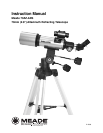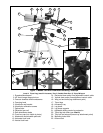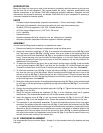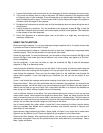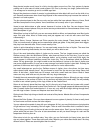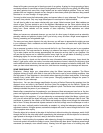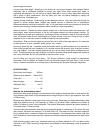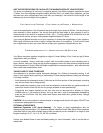
– 7 –
Nine planets (maybe more!) travel in a fairly circular pattern around our Sun. Any system of planets
orbiting one or more stars is called a solar system. Our Sun, by the way, is a single, yellow dwarf star.
It is average as far as stars go and is a middle aged star.
Beyond the planets are clouds of comets, icy planetoids and other debris left over from the birth of our
sun. Recently astronomers have found large objects in this area and they may increase the number of
planets in our solar system.
The four planets closest to the Sun are rocky and are called the inner planets. Mercury, Venus, Earth
and Mars comprise the inner planets. Venus and Mars can be easily seen in your telescope.
Venus is seen before dawn or after sunset, because it is close to the Sun. You can observe Venus
going through crescent phases. But you cannot see any surface detail on Venus because it has a very
thick atmosphere of gas.
When Mars is close to the Earth, you can see some details on Mars, and sometimes even Mars’ polar
caps. But quite often, Mars is further away and just appears as a red dot with some dark lines
crisscrossing it.
Jupiter, Saturn, Uranus, Neptune and Pluto comprise the outer planets. These planets, except for
Pluto, are made mostly of gases and are sometimes called gas giants. If they had grown much bigger,
they may have become stars. Pluto is made mostly of ice.
Jupiter is quite interesting to observe. You can see bands across the face of Jupiter. The more time
you spend observing these bands, the more detail you will be able to see.
One of the most fascinating sights of Jupiter are its moons. The four largest moons are called the
Galilean moons, after the astronomer Galileo, who observed them for the first time. If you’ve never
watched the Galilean moons in your telescope before, you’re missing a real treat! Each night, the
moons appear in different positions around the Jovian sky. This is sometimes called the Galilean
dance. On any given night, you might be able to see the shadow of a moon on the face of Jupiter, see
one moon eclipse another or even see a moon emerge from behind Jupiter’s giant disk. Drawing the
positions of the moons each night is an excellent exercise for novice astronomers.
Any small telescope can see the four Galilean moons of Jupiter, plus a few others, but how many
moons does Jupiter actually have? No one knows for sure! Nor are we sure how many Saturn has
either. At last count, Jupiter had over 60 moons, and held a small lead over Saturn. Most of these
moons are very small and can only be seen with very large telescopes.
Probably the most memorable sight you will see in your telescope is Saturn. Although you may not see
many features on the surface of Saturn, its ring structure will steal your breath away. You will probably
be able to see a black opening in the rings, known as the Cassini band.
Saturn is not the only planet that has rings, but it is the only set of rings that can be seen with a small
telescope. Jupiter’s rings cannot be seen from Earth at all—the Voyager spacecraft discovered the ring
after it passed Jupiter and looked back at it. It turns out, only with the sunlight shining through them,
can the rings be seen. Uranus and Neptune also have faint rings.
Optional color filters help bring out detail and contrast of the planets. Meade offers a line of inexpensive
color filters.
Beyond the Solar System: Once you have observed our own system of planets, it’s time to really travel
far from home and look at stars and other objects.
You can observe thousands of stars with your telescope. At first, you may think stars are just pinpoints
of light and aren’t very interesting. But look again. There is much information that is revealed in stars.
The first thing you will notice is that not all stars are the same colors. See if you can find blue, orange,
yellow, white and red stars. The color of stars sometimes can tell you about the age of a star and the
temperature that they burn at.
Other stars to look for are multiple stars. Very often, you can find double (or binary) stars, stars that
are very close together. These stars orbit each other. What do you notice about these stars? Are they
different colors? Does one seem brighter than the other?



